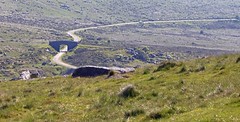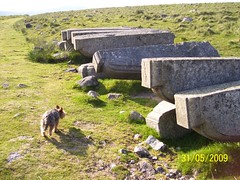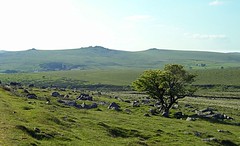Previously Walking Dartmoor 4
The plan had been Nun’s Cross Farm. The plan had always been Nun’s Cross Farm. This is a Dartmoor destination. A goal in my mind for a number of years but always eluding me.
15:00, I was still in Princetown.

I am not sure how it happened (well a wrong turning is the explanation) but I ended up walking the disused Kings Tor Railway. I briefly considered heading back but there seemed little value in that. I would continue on the path my feet were taking me, there was no reason not too.
It was absolutely scorching hot and I was over-dressed. Almost anything constituted overdressing, but in the world of skin cancer images my clothes remained attached. Many people were less inhibited about future health concerns. I was rather more concerned about their short-term prospects. Some of them already had the overseas football supporter hue about them.
Lobster pink.
Dog 2 was holding up very well. He is not completely convinced that walking on disused railway lines is what his paws were intended for, but there was an easily accessible grass verge if he felt the need for a change. We were both frequently stopping for water breaks, it was that sort of afternoon.
To my right “The Steely Stain”, towers over me. It is a radio mast sitting atop North Hessary Tor (the delight of the internet). Built in the 1950’s it is 197 metres high sitting on top of a tor 517 meters high. It can be seen great distances over the moor. I am not a fan of it at all, that is until I wish to take a bearing or get a general idea of where I am. Then I am a huge fan of it. Also useful for gauging the height of cloud.
The second highest transmission tower in the UK, falling short of the first by some 14meters. There is no threat to being second, but there is little kudos. Silver medals are forgotten quickly.
It has been beaming modernity to Devon and Cornwall since the late 50’s. TV, the great educator, now pensionable and senile, has only a few lucid moments. Our lives are spent sitting around it wondering if such a moment will come this evening. Nope, another day of your life wasted watching Eastenders and Big Brother.
Every so often a program reveals what it is like outside the front door for those without the imagination or opportunity to step outside.
If you do travel up to the tower you can find a carved plaque with the BBC motto “Quaecunque”. It replaced “Nation speaks unto Nation” in 1934, before “Nation speaks unto Nation” was brought back to life experimentally in 1948. So why is it carved on a tower of the 1950’s.
On balance it has done more good than harm. I toy with the idea of climbing up the tor to see it, but it looks steep, its not really on my way and does not quite fit in with my remit of late industrial archaeology on Dartmoor. If the tor had been slightly less steep, or the day a bit younger (or me) I would have been less pedantic. Sure rules are made to be broken, but that tends to apply to other peoples rules. Start breaking your own and chaos is ahead. It goes on the “next time” list and on we go.
The sun was really baking down dog 2 had perfected the art of walking in the shadows and at the merest hint of me stopping he would sit in the shade. He was okay, just conserving his reserves. The sheep test was still valid.
This part of the moor is very much my old stomping ground, although I was on the outer edge of it, familiar tors and sights were greeting me. It was a homecoming.
Soon the daytrippers are left behind. They circle the safety of carparks, ready to dart into their steel caves at the first hint of danger. Many seem too timid to ever leave, I wonder how far they have come to gaze at other cars as they nibble meagre looking sandwiches.
Time was working against the more adventurous, they would have to be getting back to their campsites. Soon the moor would be left to just the “daredevil roisterers”.
A chap on a mountain bike zoomed past, to engaged in being healthy and maybe having a good time to do much more than vaguely acknowledge my existence with a flick of his eyes. My puritanical reaction is to not like mountain bikes. Too fast.
By now I have accepted the fact a navigational error has sent me in the wrong direction and regained my mental bearings. I will complete a section of the railway unexplored by myself., standing where previously I have only seen, and look upon places already walked.
Why is it so difficult for me to get to Nun’s Cross farm? Are the piskies up to mischief?
The rail contortions of the Royal Oak tramway sidings which go off to Foggintor Quarry were for the return journey tomorrow. Now I was sticking to the main line, Dartmoor’s first iron railroad.
The views were opening out, in the distance I could see the incongruous remains of a railway bridge, no rail going across, no rail below it. I had walked under it many times, a brief pause to remember the dog sitting at home who had accompanied me so many times and the one keeping him company that will in the future.
The rail bed splits again, part of it snakes around the Tor, the original tramline, this is the one I choose to follow. It is grassy and level with great views over to Vixen Tor, Pew Tor and the Walkham Valley in one direction, Merrivale the other. This is where I am going to spend the night. High above an area of Dartmoor I know well.
That was for later, there was unfinished business on this line. Again a promise to myself.
Around the turn of the 20th century the London Bridge was being extended and so needed some more granite corbels. This granite came from Dartmoor, Sweltor to be precise. The siding is just a little further along.
Taking Sweltor siding and passing the remains of industry lying perfectly carved are London bridge corbels surplus to requirement. They have sat there since 1903 they look like being there to the end of time, just waiting by a track that has disappeared for a train that will never arrive.

The bridge they were destined for, has since moved to the USA, so stranger things have happened than the movement of a few granite corbels. Spares in case the new owners should need them.
Dog 2 celebrated by jumping on them and licking one, it all seemed in keeping.
These are the clearly defined reminder of labour gone. 100 years ago this was a busy industrial landscape, natural rock was being hard won to man’s line and form. They are part of the continuum of granite use, the Merrivale stone rows, rough hewn gateposts, crosses, farm troughs. The corbels are part of that historical landscape. As far as I know they are the best left example of carved granite on Dartmoor from the last period of Dartmoor’s industrial heritage. These are not the twee re-imaginings of the heritage industry or some artistic impression, this is the reality.
This was my terminus also, as far as I went. Four years had elapsed from the time I had set myself the task of seeing these corbels to the point at which Dog 2 was kissing them. They had waited for me and I turned and started back sure in the knowledge they would forever wait for me to return and one day I will.
For now though I was heading back to cook some food and sit with views of tors I consider old friends watching the shadows grow long and the heat of the day bleed out of the sky.

I could see the heavy scarring in the landscape from the Merrivale Granite Quarry. I have cursed this in the past but now I understand its place in the scheme of things. It was the last of the large scale granite quarries, where the rock was gathered for the Falklands Memorial.
A friend of mine had recently gone over to the Falklands to mark the passing of 25 years.
Dartmoor granite honouring the heroes of our past. At the going down of the sun, I remembered them.
I was in good company with a faithful companion. It had been a great day.

Dartmoor has so much to discover. I plan to walk there again. History and fine walking easily combined. We see a wild land yet it has been lived on, worked on and is so much a man made landscape in many ways.
ReplyDelete